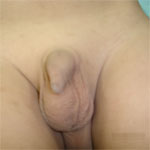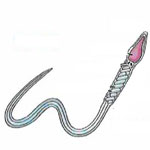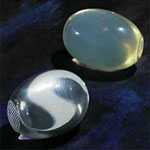NOTE: Some of the information provided contains graphic, medical images which individuals may find upsetting
What should I do if I have a testicle missing?
If you or your child have a testicle which is not in the normal (scrotal) position, you should contact your GP for further advice
Your GP may be able to find the missing testicle by simple examination. He/she will also be able to advise you on whether the rest of your genitourinary tract requires investigation.
The commonest reason for a testicle which cannot be seen or felt is that it is retractile, meaning that it moves upwards. This is especially common in children and is not of any concern. Your GP may be able to demonstrate retraction. This usually means that no immediate treatment is needed, provided the testicle can be brought to the bottom of the scrotum. Retractile testicles usually become less so with time and spend progressively more time in the scrotum with less time in the groin.
What are the facts about a missing testicle?
- The commonest cause of a missing testicle is that it is retractile and not actually undescended;
- An undescended testis is one which cannot be brought down into the scrotum or felt within the scrotum;
- An undescended testicle is seen in 4% of boys at birth;
- Spontaneous descent occurs in 75% of these boys over the first 3 - 6 months leaving 1% of all boys with an undescended testicle after this time;
- There are several significant risks when a testicle is undescended (see below);
- There is an association with other abnormalities of the urinary tract (kidneys, ureters, bladder & urethra);
- Surgical re-location of the testicle (orchidopexy) is needed in most children with an undescended testicle and is best performed before the child's first birthday; and
- In adults, removal of the undescended testicle (with insertion of an artificial testicle, if requested) is usually the treatment of choice.
What should I expect when I visit my GP?
Assessment for patients with a missing testicle usually involves a simple examination only but may include some or all of the following:
A full history
Your GP will take a full medical history. He/she will should enquire about the use of drugs during pregnancy, whether the testicle was present when the scrotum was assessed after birth, any previous surgical history and whether there is any family history of undescended testis or any other syndromes.
A physical examination
 A full physical examination will be performed, including examination of the scrotum (pictured). This is best performed in comfortable, warm surroundings. It may then be possible to identify a retractile testicle or feel the undescended testicle in an abnormal site.
A full physical examination will be performed, including examination of the scrotum (pictured). This is best performed in comfortable, warm surroundings. It may then be possible to identify a retractile testicle or feel the undescended testicle in an abnormal site.
Additional tests
a. General blood tests
Your GP will decide whether any blood tests are necessary but, in most patients, they are not.
b. Other specific tests
A routine urine stick test will normally be performed. Your GP may arrange an ultrasound, CT scan, MRI scan or a hormone (HCG) stimulation test. These tests, however, are normally requested only by the urology or paediatric department after hospital assessment. and, in most patients, are not usually required.
What could have caused my missing testicle?
The causes of undescended testicle are complex and poorly-understood but there is an association with other congenital abnormalities of the urinary tract.
The testicle develops inside the abdomen, just below the developing kidney. It normally descends into the scrotum by the 32nd week of pregnancy. This is a complex process governed by hormones (male & female), the pressure inside the abdomen and a structure known as the gubernaculum (which acts as a tissue wedge to stretch up the passage between the groin and the scrotum). Defects in all these mechanisms contribute in varying amounts to incomplete descent of the testicle.
What treatments are available for this problem?
4% of children have an undescended testicle at birth but 75% of these testicles descend by the age of 3 months. By the age of 1 year, an undescended testicle is unlikely to come down by itself.
The risks of an undescended testicle are:
 reduced fertility in later life (especially if both testicles are affected). Testicles produce sperm (pictured) ideally at a temperature 1-2ºC below body temperature. This temperature is achieved when the testicle is in the scrotum but sperm production is impaired when the testicle lies in the groin (i.e. at normal body temperature);
reduced fertility in later life (especially if both testicles are affected). Testicles produce sperm (pictured) ideally at a temperature 1-2ºC below body temperature. This temperature is achieved when the testicle is in the scrotum but sperm production is impaired when the testicle lies in the groin (i.e. at normal body temperature);- increased risk of testicular cancer (up to 40-times increased risk in later life);
- an associated hernia (found in 90% of boys with an undescended testicle);
- twisting of the undescended testicle which blocks its blood supply and causes it to die;
- an increased liability to injury in the groin. Testicles situated normally in the scrotum are mobile and less prone to injury by external forces; and
- psychological and cosmetic embarrassment in children or young adults.
For these reasons, early treatment is normally recommended, as below.
Hormone treatment

Using hormones to stimulate testicular descent in children works best with low-lying testicles. The success rate is less than 20%, so surgery remains the "gold standard" for treatment. Your paediatric urologist will advise you on whether hormone treatment is appropriate for your son. Hormone treatment is ineffective in adults with an undescended testicle.
Bringing the testicle into a normal position is the procedure of choice in children, and is best performed during the first year of life; at that stage, it reduces the risk of testicular cancer developing later in life. However, it probably does not reduce this risk to zero. The procedure involves freeing of the testicle in the groin, repairing the associated hernia and positioning the testicle securely in a pouch in the scrotum.
Download a leaflet about orchidopexy

High-lying testicles, especially those within the abdomen, may require a more complex procedure. It may not always be possible to bring these testicles into the scrotum and, in some children, removal of the testicle will be needed. If it is suspected that the testicle is lying within the abdomen, a preliminary laparoscopy (keyhole inspection of the abdominal cavity) may help to confirm its exact position. Laparoscopy (pictured above right) will also confirm whether the testicle has not formed at all (seen in 5% of children with a missing testicle).
Download a leaflet about keyhole inspection of the abdominal cavity
Removal of the undescended testicle
In adults (beyond the age of puberty), removal of the testicle is normally advised. Even if the testicle is brought down, it is unlikely to have any capacity to produce sperm and there is still a risk of testicular cancer later in life. Insertion of an artificial testicle (pictured right) can be performed as part of this procedure.
Download a leaflet about removal of a testicle
Download a leaflet about insertion of an artificial testicle